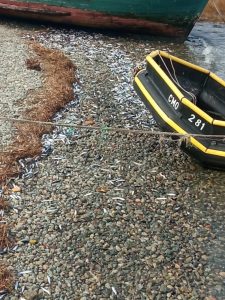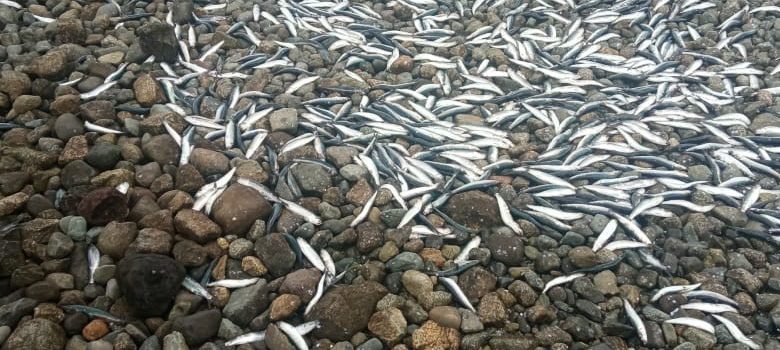IFOP points out that harmful algal blooms are not linked to anchovy stranding in Los Lagos Region Cochamó sector, Reloncaví fjord
April 12th, 2023 Derived from anchovies stranding, recorded in Cochamó town in the Reloncaví fjord, on April 1rst and 2nd, 2023. IFOP’s Harmful Algae Research Center (CREAN) evaluated oceanographic conditions, harmful microalgae and marine toxins statee, in eight stations located between Cochamó and Caleta La Arena, which are permanently monitored by Red Tide Program in Fjords. Complementary information was provided by Sernapesca, who verified that the event was punctual, affected a low fish biomass, and was mainly concentrated on Cochamó beach. They also reported that, due to predators action, there were no longer any dead fish specimens left on the beach. beach or surroundings. For their part, local fishermen confirmed that stranded species corresponded to anchovy specimens.
Derived from anchovies stranding, recorded in Cochamó town in the Reloncaví fjord, on April 1rst and 2nd, 2023. IFOP’s Harmful Algae Research Center (CREAN) evaluated oceanographic conditions, harmful microalgae and marine toxins statee, in eight stations located between Cochamó and Caleta La Arena, which are permanently monitored by Red Tide Program in Fjords. Complementary information was provided by Sernapesca, who verified that the event was punctual, affected a low fish biomass, and was mainly concentrated on Cochamó beach. They also reported that, due to predators action, there were no longer any dead fish specimens left on the beach. beach or surroundings. For their part, local fishermen confirmed that stranded species corresponded to anchovy specimens.
During the last week of March, the oceanographic conditions were for a surface water layer, up to ten meters deep, characterized by a warm temperature (15°C), with low salinity (<20 UPS) and well oxygenated (<8 mL/L), conditions that are common when freshwater contributions are recorded from rivers that flow into this fjord. Regarding harmful microalgae, dinoflagellate Dinophysis acuminata was the species that showed highest levels of relative abundance (AR = 7 and 8), however, no marine toxins were detected in shellfish according to analyzes carried out by Health Ministerial Secretariat (Seremi) from Los Lagos, data that were confirmed by analyzes performed at CREAN through HPLC MS/MS. The species that numerically dominated phytoplankton composition were diatoms Skeletonema spp. and (8,100,000 – 17,974,000 cells/L) and Ditylum brigthwellii (274,000 – 521,000 cells/L), Ditylum brigthwellii (274.000 – 521.000 cél/L), both of very high abundance in the area.
Additionally, on April 4th, sampling was carried out at three stations in the fjord, where live phytoplankton samples were collected in order to assess ichthyotoxic microalgae’s presence. The results show ichthyotoxic microalgae absence, cell abundance decrease and permanence of the dominance of Skeletonema spp. and Ditylum brigthwellii, especially in stations located at the outlet of the Reloncaví fjord. On the other hand, from marine toxins analyzes in phytoplankton from HPLC MS/MS, only a very low concentration (0.08 ng/L) of Pectenotoxin (PTX-2) was detected, which would be related with high values of abundance of Dinophysis acuminata.
Oscar Espinoza González, Harmful Algae Research Center (CREAN)’s Head explained “we must remember that species such as anchovies can be affected by temperature sudden changes, salinity or lack of oxygen, however, no anomalies were observed in analyzed data. in these variables and especially in the concentration of dissolved oxygen. Neither was evidence found that the event was caused by marine toxins associated with any harmful microalgae. However, lipophilic toxins periodic evaluation should be maintained, especially due to the high levels of relative abundance of Dinophysis acuminata and pectenotoxins findings of phytoplankton samples. This toxin is not regulated from a Public Health point of view. On the other hand, it is proposed that high concentrations of phytoplankton, particularly Skeletonema spp. inside the Reloncaví fjord, it was able to induce anchovies entry into the fjord in search of this food, seeing itself confined to more closed areas such as Cochamó sector and its surroundings.
Stranding events of small pelagic fish (sardines and anchovies) have previously been recorded during the autumn in the Reloncaví fjord, a period where it is known, through oceanographic research conducted by IFOP, that water masses of more oceanic origin enter the interior of the fjord, which contain high concentrations of nutrients, favoring phytoplankton biomass increase and with it, these pelagic fish abundance.
The recorded event of stranding of fish reflects fjords and channels susceptibility to atmospheric-oceanographic variations associated with climatic change in southern Chile, which can affect precipitation patterns and freshwater inflow through river discharge. water column mixing/stratification processes , nutrients availability , variables that can modify phytoplankton composition and with it food web that includes zooplankton and fish of different sizes. Research maintenance in these systems, activities coordination that make it possible to anticipate eventual scenarios and impacts derived from climatic change, are necessary actions in a changing environment and, of course, it is imperative to continue generating information that supports decision-making and contributes to these systems sustainability.
Press related links:
